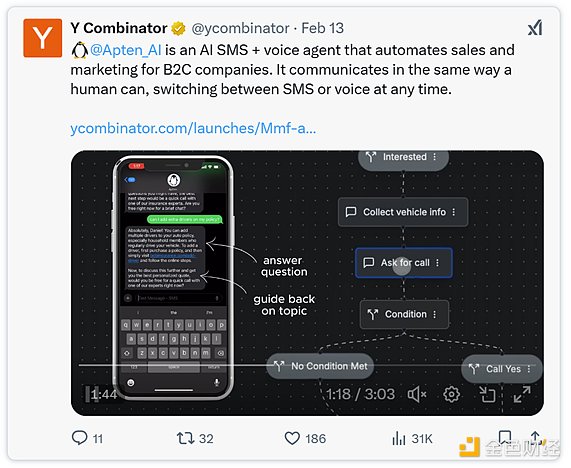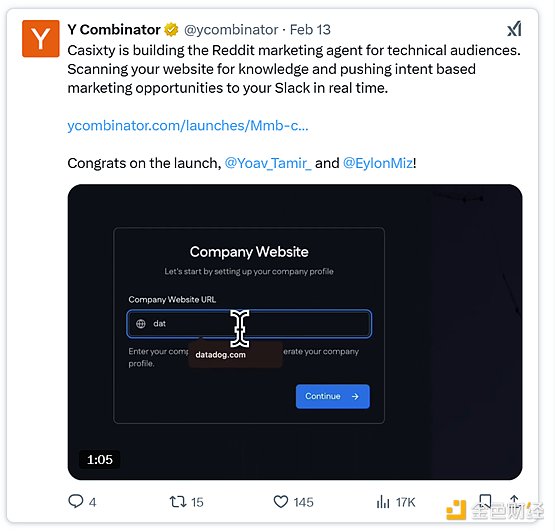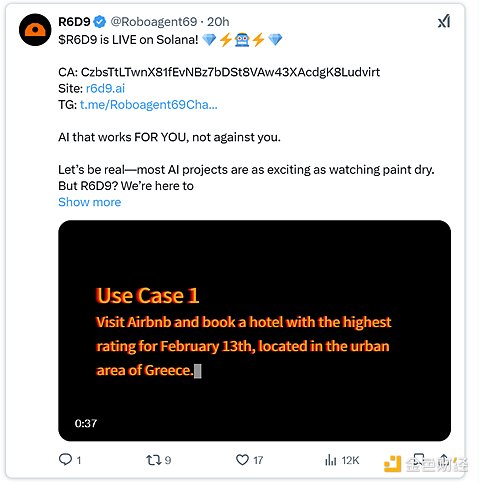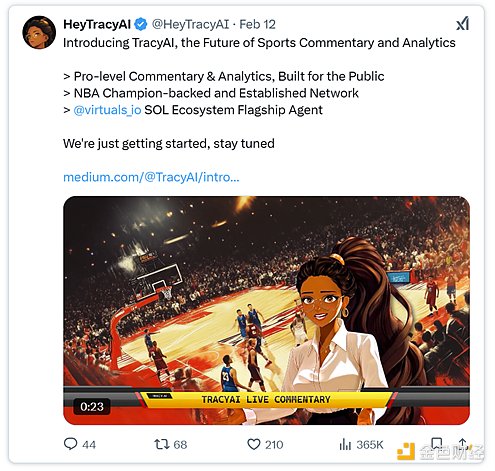Author: 0xJeff, Head of Steak Studio; Translator: Jinse Finance xiaozou
When we look at the wide range of applications beyond Web3, whether it's large enterprises or small companies, many businesses have already started integrating AI Agents into their daily operations - including sales, marketing, finance, legal, IT, project management, logistics, customer service, and almost every imaginable area of workflow automation.
We have transitioned from the era of manual data processing, repetitive tasks, and Excel spreadsheet filling by humans, to the era of autonomous operation by digital workers (AI agents). These agents not only have higher efficiency, but also significantly lower costs.
Web2 companies are willing to pay $50,000 to $200,000 or more for AI-driven sales and marketing agents. Many agent providers operate high-profit businesses through SaaS subscription models or usage-based models (charging by token usage).
1. Application Scenarios of AI Agents in Web2: Insights from Y Combinator
Apten - an agent tool that combines artificial intelligence and SMS technology to optimize sales and marketing processes.

Bild AI - an AI tool that can read construction blueprints, extract material and specification data, and estimate costs based on the collected information.

Casixty - a marketing agent tool that can identify popular topics on Reddit, automatically generate responses, and increase brand interaction. Imagine the impact if this product was applied to the CT (Crypto Community)!

These cases demonstrate how AI agents are transforming traditional industries, automating manual tasks, and optimizing workflows. While Web2 companies have quickly adopted AI-driven agent technology, the Web3 domain is also embracing this technology - but with a key difference.
Unlike Web2, which is solely focused on operational efficiency, Web3 AI agents are deeply integrated with blockchain technology, unlocking entirely new application scenarios.
2. Web3 AI Agents: Beyond "Chatbots"
A few months ago, most Web3 agents were just chatbots on Twitter. However, this landscape has undergone significant changes. Today, these agents are integrating with various tools and plugins, enabling them to perform more complex operations.
@sendaifun - a Solana AI agent toolkit that supports a range of functions, from basic token management to complex DeFi operations.
@ai16zdao - integrated with over 100 plugins, covering social media interaction, automated trading, and DeFi operations.
@Cod3xOrg, @Almanak__ - no-code infrastructure that allows users to create autonomous trading agents.
@gizatechxyz - a self-directed DeFi assistant designed for investors.
As the largest segment of the crypto space (with a total locked value exceeding $100 billion), DeFi has become the most influential crypto-native AI agent application scenario, known as DeFAI (Decentralized Finance Artificial Intelligence).
AI agents in DeFi not only simplify complex operations through natural language processing (NLP) interfaces, but also unlock new opportunities by leveraging on-chain data. Blockchains provide a wealth of structured data - including credentials, transaction histories, profit and loss records, governance activities, and lending patterns. AI can process and analyze this data to extract insights, automate workflows, and optimize decision-making.
3. Web2 Vertical Domain Agents Based on Crypto Infrastructure
We have also witnessed the emergence of Web2 vertical domain agents that integrate crypto-native models. A typical example is Virtuals.io's launch on Solana.
Perspective AI - an AI-driven fact-checking tool that continuously improves through community feedback.

R6D9 - a personal assistant tool that can book flights, taxis, order groceries, and schedule meetings.

HeyTracyAI - an AI-driven sports commentary and analysis platform, initially focused on the NBA.

Unlike traditional SaaS (Software as a Service) models, these agents often employ a token-gated mechanism, where users need to stake or hold a certain amount of tokens to gain advanced access privileges, while still being able to use the basic-level services for free. Their revenue sources primarily depend on token transaction fees and API usage fees.
4. Can Web3 AI Agents Compete with Web2 Startups?
In the short term, Web3 teams face challenges in finding product-market fit (PMF) and achieving meaningful user adoption. They need at least $1-2 million in annual recurring revenue (ARR) to effectively compete. However, from a medium to long-term perspective, the Web3 model has inherent advantages:
Community-driven growth: Token incentives and aligned interests drive organic community growth.
Global liquidity and accessibility: Decentralization and non-custodial platforms eliminate adoption barriers, enabling seamless global access.
Furthermore, the rise of DeepSeek and the interest of Web2 AI talent in open-source AI are further accelerating the synergy between the crypto domain and artificial intelligence.
5. Core Application Scenarios of Crypto-native AI Agents
DeFAI (Decentralized Finance Artificial Intelligence) - abstraction layer, automated trading agents, and staking/lending/borrowing solutions: Providing front-end support for DeFi infrastructure, improving the efficiency and user experience of DeFi products.
Research and Reasoning Agents - AI-driven research assistants: Analyzing data, filtering noise, and generating actionable insights. My recent favorite is the security agent. @soleng_agent is a developer relations agent focused on analyzing GitHub codebases to help developers optimize their projects. @CertiK_Agent provides AI-based audit services to identify potential threats (an agent scoring system is upcoming) and ensure the security of smart contracts and blockchain projects.
Data-driven AI Agents - Leveraging on-chain data and social media data to enable autonomous decision-making and execution.
These three vertical domains represent the most promising development directions for crypto-native AI agents.
6. Current Status and Future Outlook
Over the past month, the market has been consolidating, with Altcoins and AI agent-related tokens experiencing significant corrections. However, we are entering a phase where the fundamentals of these tokens are becoming clearer.
AI agents in Web2 vertical domains have proven their value, and many enterprises are willing to pay high fees for AI-driven automation services. At the same time, while Web3 vertical domain AI agents are still in the early stages, their potential is immense. By combining token incentives, decentralized access, and deep integration with blockchain data, Web3 AI agents have the opportunity to surpass their Web2 counterparts and achieve more far-reaching development.
However, the core question remains: Will Web3 vertical domain AI agents reach adoption levels comparable to Web2, or will they fundamentally reshape this domain by leveraging blockchain native advantages?






